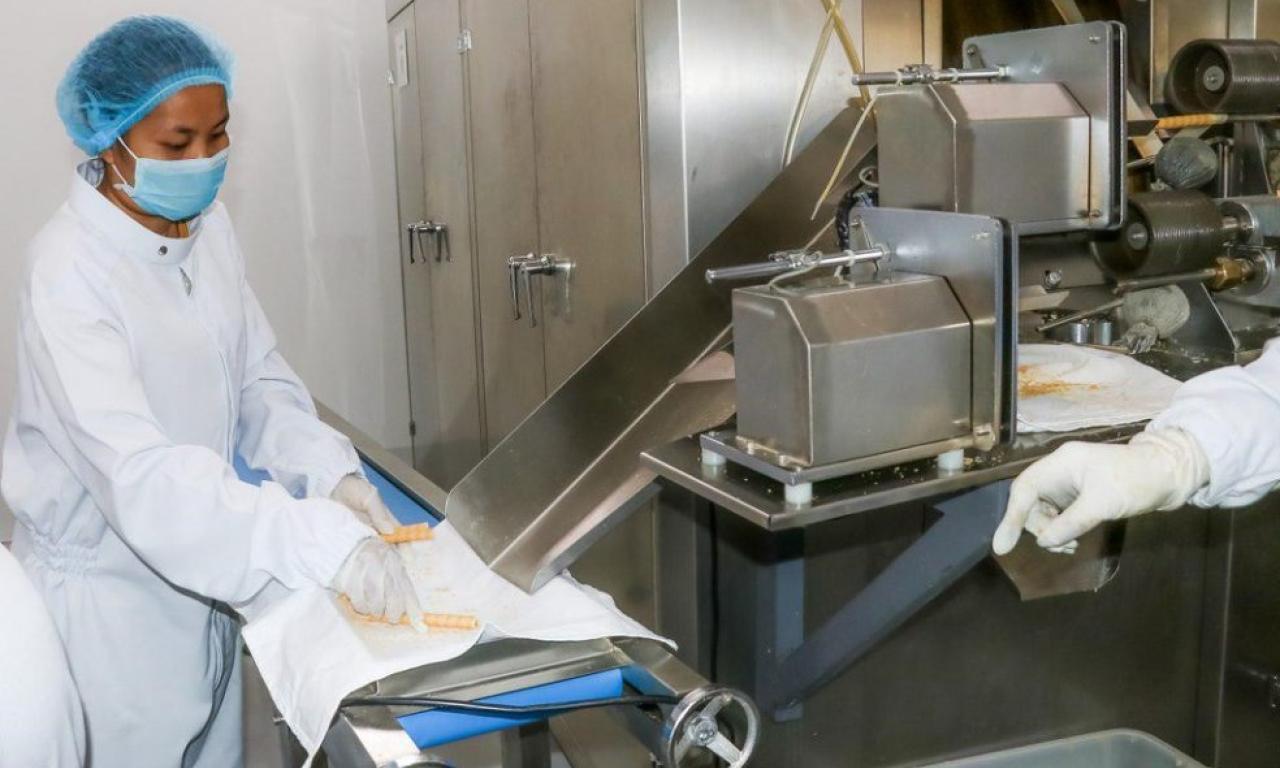
WorldFish’s Global Lead for Nutrition and Public Health, Aquatic Food Systems, and Vice Chair of the 2021 UN Food System Summit Action Track 4: Advance Equitable Livelihoods, Dr. Shakuntala Thilsted, shares her experience developing nutrition-sensitive innovations that are transforming women’s lives.
WorldFish’s Global Lead for Nutrition and Public Health, Aquatic Food Systems, and Vice Chair of the 2021 UN Food System Summit Action Track 4: Advance Equitable Livelihoods, Dr. Shakuntala Thilsted, shares her experience developing nutrition-sensitive innovations that are transforming women’s lives.
One in every two workers in aquatic food systems are women. Some of these women work directly in fisheries and aquaculture production, while the majority work in the processing, sale, and trade of aquatic foods and products. Women are crucial to aquatic food systems, providing labor, innovative ideas, and entrepreneurship. Their contributions are critical to food and nutrition security, gender equality, and multiple Sustainable Development Goals.
Gender bias, outdated assumptions, and the lack of visibility in food system policy block women’s full participation in aquatic food systems and thus hold back true food systems transformation toward more healthy and sustainable diets. COVID-19 has intensified many of the disproportionate burdens that women face, critically impacting access to job opportunities and nutritious foods. ‘Building Forward Better’ requires the full participation of women in crucial response and recovery efforts.
Applying a nutrition lens to aquatic food systems, through nutrition-sensitive approaches, is sparking multiple innovations from production to consumption that challenge gender bias and champion the role of women in low- and middle-income countries.
What are nutrition-sensitive approaches in aquatic food systems?
Nutrition-sensitive approaches put human health and nutrition as a principal objective in the management of aquatic food systems, such as fisheries and aquaculture. Nutrition-sensitive approaches are multipronged, producing innovations at multiple entry points to the food system, from production, post-harvest, marketing to consumption and waste. Pioneered by WorldFish and partners in the One CGIAR and beyond, these approaches are fostering women’s engagement in aquatic food production, improving equal access to resources and entrepreneurial opportunities, and boosting the consumption of diverse, nutritious diets.
Innovation 1: Integrated land and water food production systems
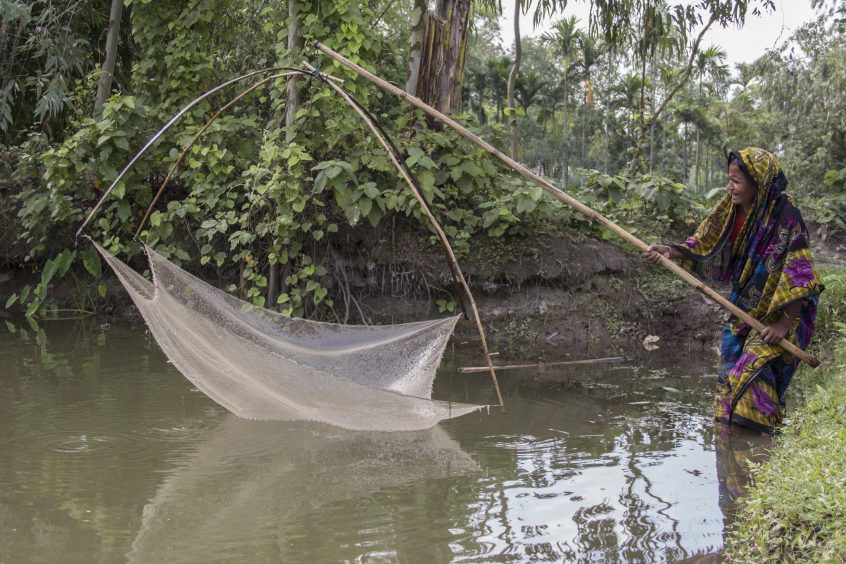
With a homestead farm, women have more access to income source, improving their finances, and expand their roles in household management and decision-making. Photo by Holly Holmes.
Nutrition-sensitive approaches in fisheries and aquaculture encourage the integrated production of diverse fish species together with vegetables in backyard ponds, coastal and inland waters, such as fish-rice systems. The multidimensional approach educates both women and men on the health and nutrition benefits of consuming diverse foods and developing their capacity around polyculture pond practices–which sees large fish like carp species grown together with small indigenous fish species–integrated with the cultivation of diverse vegetables, such as vitamin A-rich orange sweet potato.
With more food in the homestead farm, women have the opportunity for an additional income source, improving their finances, hence expanding their roles in household management and decision-making. A key success of this initiative is the shift to the cultivation and consumption of small fish. Small fish are a superfood, rich in multiple essential micronutrients, including iron, zinc and vitamins B12 and A and essential fatty acids, as well as animal protein. Vitamin B12, obtainable only from animal-source foods, is essential for brain and cognitive development of young children.
Nutrition-sensitive aquatic food systems were first pioneered by WorldFish and partners in Bangladesh. Today, the innovation has been adopted by over 700,000 households with numbers increasing thanks to the Government of Bangladesh, which has backed the innovation in its growth policy. The approach has also been scaled and adapted in Cambodia and Myanmar, India and parts of Africa.
Innovation 2: Small fish powder reimagines nutrient-rich meals
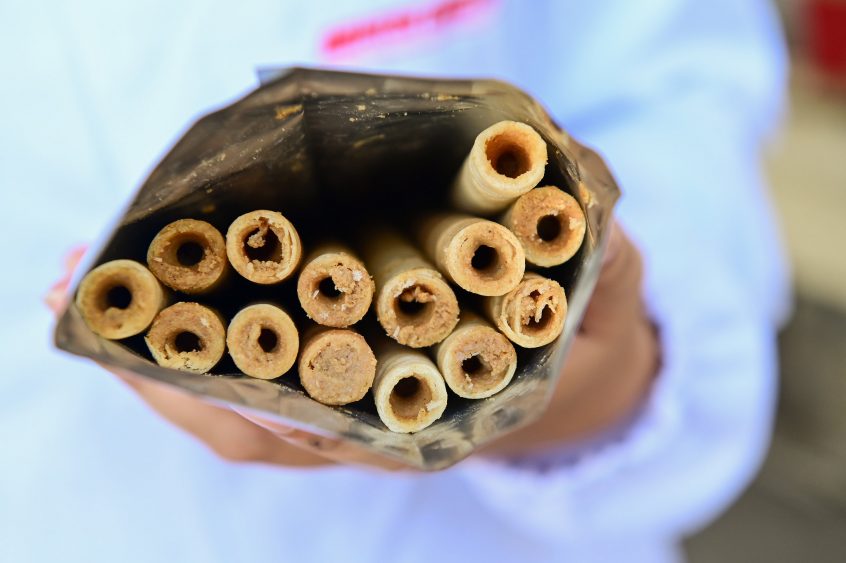
Despite being full of nutrients essential for cognitive growth, in many parts of the world, fish are not an acceptable food for children or pregnant and lactating women. WorldFish and partners have worked to develop innovative, locally acceptable fish products that can be consumed by all. Small fish species dried and turned into a powder, using simple processing methods is being used to boost the nutritional value of local recipes. The dried fish powder has an extended shelf life, positioning it as a safe and accessible option to boost the nutritional value of a meal for those who lack access to markets.
Working with women in Asia, Africa and the Pacific, WorldFish has identified and developed methods for easily adapting dried fish into family foods. By educating mothers on the nutritional value of fish for infant development, while at the same time providing hands-on experience in processing fish powder, and trialing the powder in popular local recipes have seen a positive result in the uptake. In Malawi and Zambia, this nutrient-rich powder was incorporated into vegetable relish, soups and in orange juice. In Bangladesh and India, it was used to make condiments, like mango chutney. While in Myanmar, it has been mixed with common ingredients such as chickpea powder, sweet potato powder, palm sugar and salt to add to soup mixes. In Cambodia, dried fish powder has been processed into a snack product that has been classed as a treatment for malnourished children by the Government of Cambodia and UNICEF.
Dried small fish powder also is providing an economic opportunity for women. The inclusion of dried fish powder into processed products in Asia has provided jobs for women in food manufacturing. While in Malawi, local women’s groups are finding entrepreneurial opportunities in selling baked scones, cakes and mandazi (a fried bread) with fish powder outside of schools.
Innovation 3: Low-cost solar technologies to improve food safety and reduce loss and waste
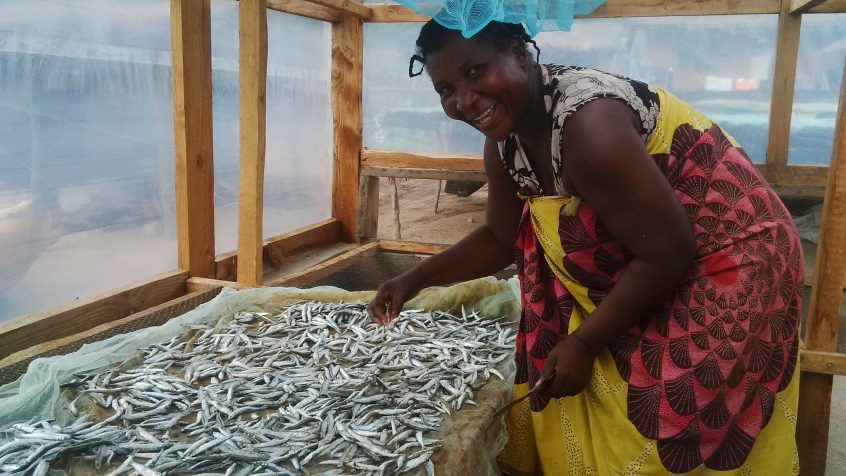
WorldFish and partners have developed and promoted low-tech solar ‘tents’ to improve the process of drying fish in Malawi. This nutrition-sensitive approach helps improve the speed, quality and food safety of dried small fish that is traded regionally.
Traditionally, many women dry fish in the open air before taking them to market. This takes up to two days and is challenged by poor weather, pests and the excessive use of salt and chemicals used during processing. Community-based solar tents, resembling a greenhouse, are made from clear plastic stretched over a large wooden structure. The tents were designed with proper aeration, drying racks and roofing, enabling better drying of more fish while eliminating the use of additives and chemicals. Just a few hours in the solar tent can be enough to dry fish. Not only do they help women get fish to the market quicker, but solar tents have also helped the fish traders get higher prices for cleaner, better-quality products.
This innovation is estimated to have improved the livelihoods of up to 250,000 women engaged in fish processing, particularly fish drying, in Malawi. The opportunity to scale solar tents throughout Africa provides a promising opportunity to transform the lives of women who account for 60 percent of those involved in the post-harvest, sale and trade of aquatic foods.
Innovation 4: Holistic policy and intervention programs transform school children’s health and nutrition
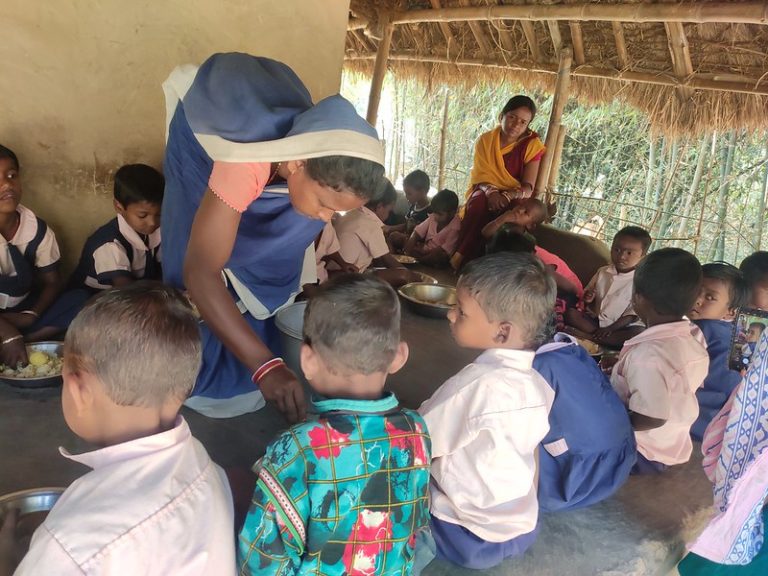
Nutrition pilot program includes fish and fish-based products into 50 rural childhood centers in Odisha, India. WorldFish archives.
Although India is the world’s second-largest fish-producing country, domestic fish consumption is only one-quarter of the global average. Women and children, in particular, often do not have access to any aquatic foods. In 2020, WorldFish signed an agreement with the Department of Women and Child Development in the coastal state Odisha to support a pilot nutrition program that includes fish and fish-based products into 50 Anganwadi centers, rural childhood centers. This decision was supported by evidence that fish and fish-based products, such as small fish powder and fish chutney, are able to address malnutrition. Depending on the results from the pilot, it is expected that the nutrition program with fish and fish-based products will be scaled up to all Anganwadi centers in the state.
Innovation 5: Busting gender myths put women in charge of aquatic food resources
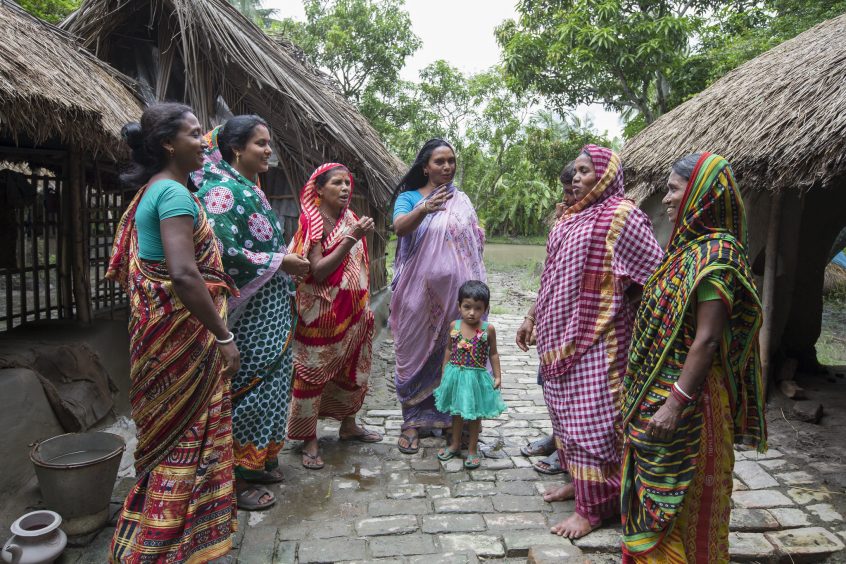
Women take control of village water tanks to produce diverse fish species in Odisha, India. Photo from WorldFish archives.
WorldFish was also instrumental in informing policies, allowing women in Odisha to engage in pond polyculture in village water tanks across the state. These traditionally restricted areas were opened up for the community, and women were encouraged to stock and harvest fish, both large and small sized. The larger fish were sold for income, while the small fish were consumed by the household members, improving livelihood through better income, as well as addressing food and nutrition security at the household level. Over 65,000 households are now benefiting from nutrition-sensitive approaches promoting the increased engagement of women in aquatic food production. Women have reported having greater participation in household matters, in making decisions with regards to income and food distribution, and able to generate income for other expenses, including schooling of their children.
Innovation 6: Seaweed a new frontier for nutritious food for women
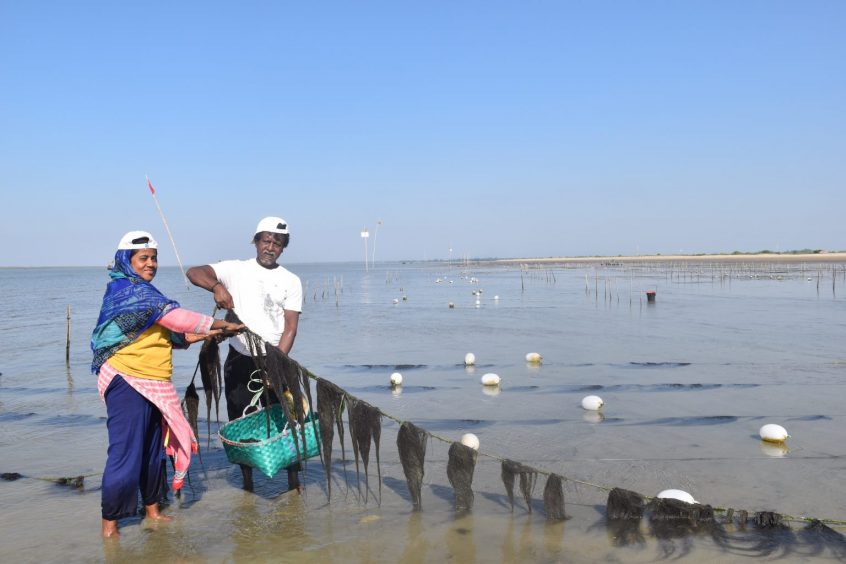
In place since 2017, a fishing ban along the Naf River in Bangladesh has left fishers and aquatic food supply chain workers, many of whom are women, in surrounding communities without a stable source of income. Seaweed farming has become a new food frontier because of its simple techniques, inexpensive equipment, and the fact that seaweed species require no feed, grow fast, absorb carbon and are easy to harvest.
WorldFish and partners are working with the Department of Fisheries in Bangladesh and local companies, to train women on seaweed farming, green mussel cultivation and post-harvest processing. Seaweed farming is providing women with a decent livelihood alternative during the fishing ban. The seaweed sector is still in its infancy, and further research is underway to examine its nutritional value and acceptability as a locally available food for consumption.